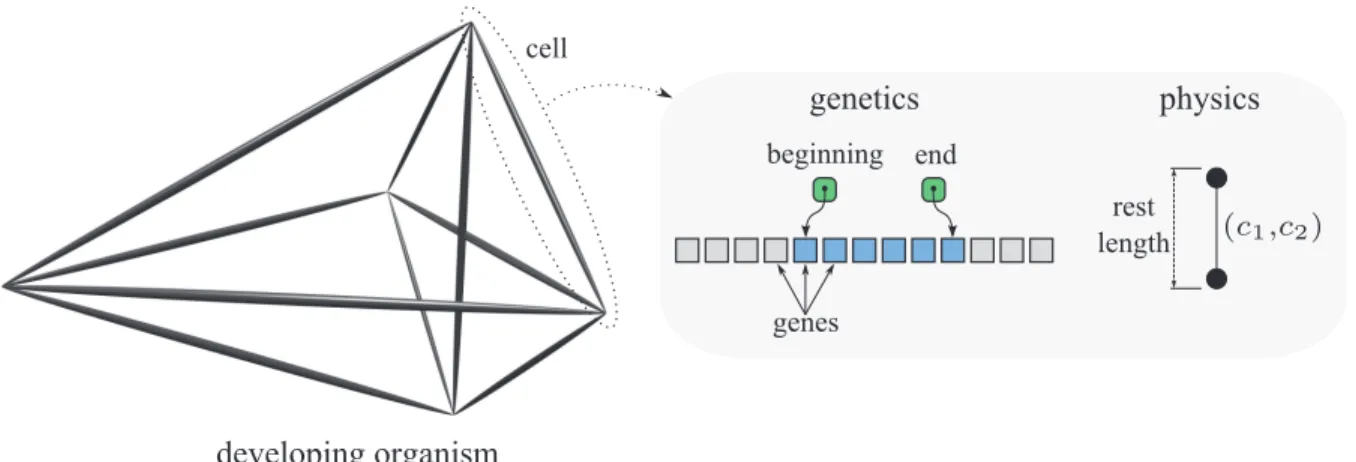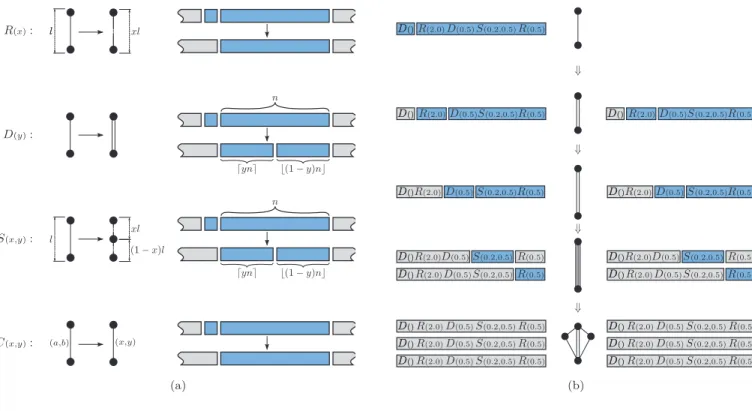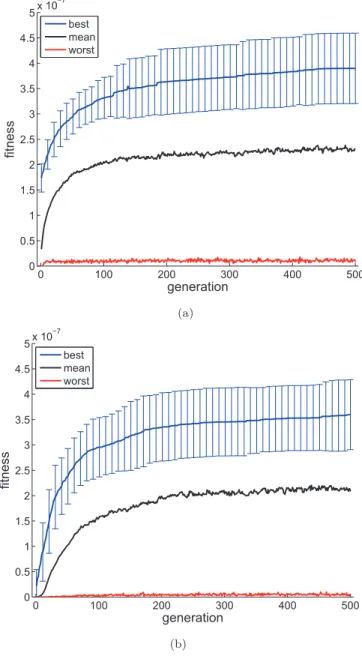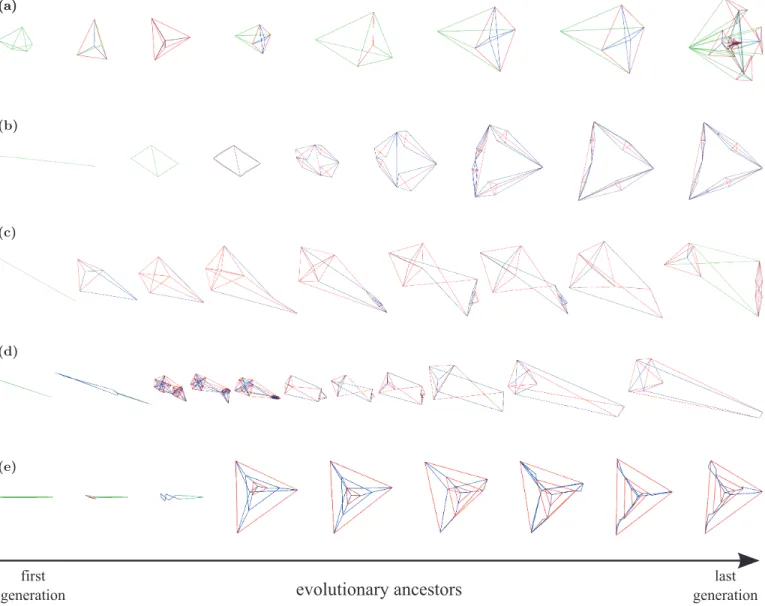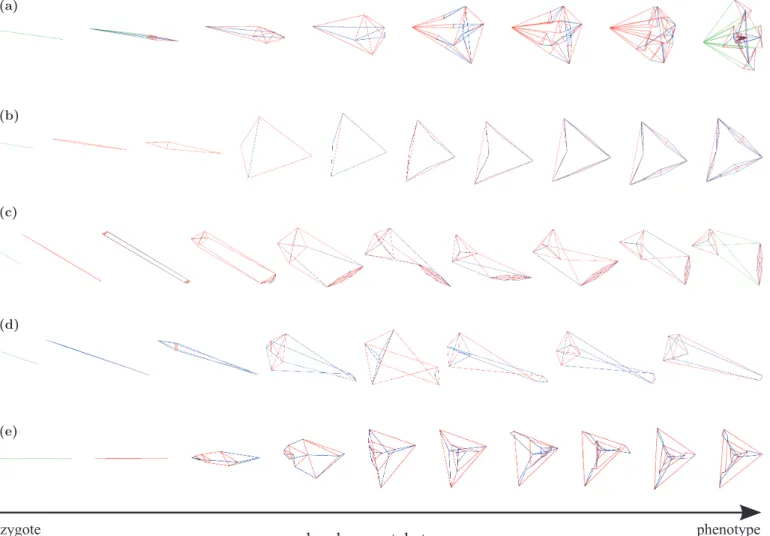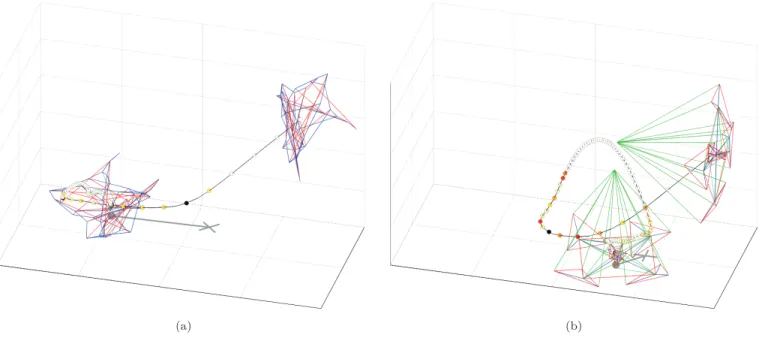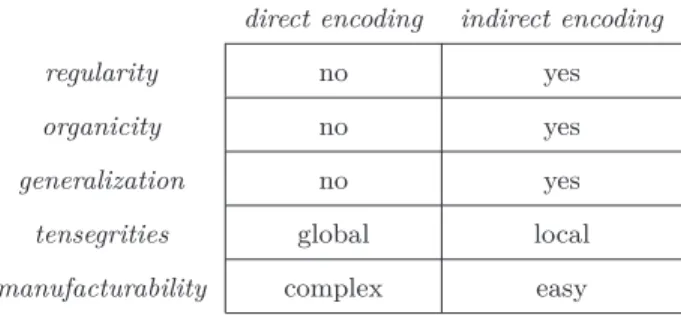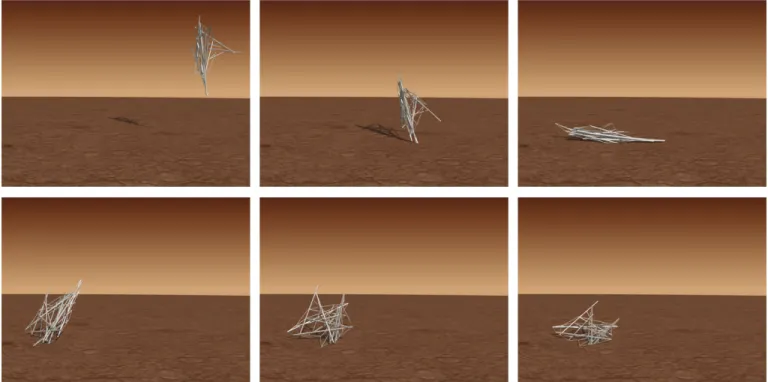Evolutionary development of tensegrity structures
Daniel Lobo∗, Francisco J. Vico
Departamento de Lenguajes y Ciencias de la Computación, Universidad de Málaga Severo Ochoa 4, 29590 Málaga, Spain
Phone: +34 952137037
Abstract
Contributions from the emerging fields of molecular genetics and evo-devo (evolutionary developmental biology) are greatly benefiting the field of evolutionary computation, initiating a promise of renewal in the traditional methodology. While direct encoding has constituted a dominant paradigm, indirect ways to encode the solutions have been reported, yet little attention has been paid to the benefits of the proposed methods to real problems. In this work, we study the biological properties that emerge by means of using indirect encodings in the context of form-finding problems. A novel indirect encoding model for artificial development has been defined and applied to an engineering structural-design problem, specifically to the discovery of tensegrity structures. This model has been compared with a direct encoding scheme. While the direct encoding performs similarly well to the proposed method, indirect-based results typically outperform the direct-based results in aspects not directly linked to the nature of the problem itself, but to the emergence of properties found in biological organisms, like organicity, generalization capacity, or modularity – aspects which are highly valuable in engineering.
Keywords: Indirect encoding, Artificial development, Evolutionary computation, Tensegrity, Form-finding
∗Corresponding author
Email addresses: dlobo@geb.uma.es(Daniel Lobo),fjvico@geb.uma.es(Francisco J. Vico)
$FFHSWHG0DQXVFULSW
/RER'DQG9LFR)-³(YROXWLRQDU\GHYHORSPHQWRIWHQVHJULW\VWUXFWXUHV´
%LR6\VWHPVSS
1. Introduction
New insights in developmental biology are configur-ing a new computational paradigm that may dramati-cally change the methodology in evolutionary comput-ing. Artificial development is a discipline that mimics the mechanisms of development, what is known as the embryological period, by means of which a group of living systems develop from one single cell into mature multi-cellular organisms. In search of methods to evolve pheno-types with a high structural complexity (resembling that of multicellular organisms), evolutionary algorithms have incorporated mechanisms inspired by embryology, such as gene expression, morphogenesis, and cellular differentia-tion (Stanley and Miikkulainen, 2003).
An important aspect in the implementation of an evo-lutionary algorithm is the genotype-to-phenotype enco-ding scheme (Komosinski and Rotaru-Varga, 2002). Tra-ditional evolutionary algorithms use a direct encoding method (i.e., the individual is represented by a row of data that is explicitly linked to its properties). However, a direct mapping has been shown to not being effective in complex problems, due to limitations in scalability, adap-tability, and evolvability (Hornby and Pollack, 2002). As a result, evolutionary algorithms with indirect encodings have been applied in a wide range of abstract problems (for a review see (Stanley and Miikkulainen, 2003)), yet the discovery of morphologies, or form-finding, that ver-ify certain constraints is one of the most promising lines of application.
A diverse set of computational paradigms that make use of developmental mechanisms and indirect encod-ings has been proposed for the problem of form-finding. Cellular automata have been used as a model of de-velopment to generate simple shapes (de Garis, 1991, 1992), biological processes (e.g. gastrulation and limb budding) (Hogeweg, 2000a,b), and specific target two-dimensional patterns (Chavoya and Duthen, 2008) and
2003; Roggen et al., 2003; Roggen and Federici, 2004; Fed-erici and Downing, 2006; Roggen et al., 2007; Andersen et al., 2009). While these models make use of develop-mental methods and indirect encodings, and constitute a great achievement in the field, they are not focused on the implementation of engineering structures; thus, their practical utility is limited.
A few researchers have applied developmental meth-ods to the form-finding of engineering structures. Shea et al. (1997; 1997) used simulated annealing to evolve shape grammars for the automation of the design process of roof trusses and discrete structures. Rudolph and Al-ber (2002) proposed an evolutionary algorithm based on genetic programming to evolve node-based graph gram-mars that encoded structures that resemble transmission towers. Finally, Lobo et al. (2009) proposed an enco-ding based on a construction tree to evolve the sequence of modifications that can transform a given truss struc-ture into a new one that serves a different function. In summary, these works represent promising examples of the application of developmental methods to the form-finding of engineering structures.
Increased attention has been devoted to structures called tensegrity, a term coined by Buckminster Fuller (1975) to denominate structures consisting of a set of rigid elements (struts) connected by a set of tensile ele-ments (strings). Tensegrities are characterized by their tensile integrity (Motro, 2006), a property that has been found in biological structures (Ingber, 1993) and used in multiple engineering problems (Tibert and Pellegrino, 2003). Consequently, it has been generated a natural in-terest in automated systems to find tensegrity structures. Several methods have been proposed for exploring sub-sets of the entire search space of tensegrity structures (for a review see (Tibert and Pellegrino, 2003) and (Juan and Mirats Tur, 2008)); however, the problem of discover-ing new and complex tensegrity structures remains open (Rieffel et al., 2009). Bioinspired methods have been
also applied to seek for tensegrity structures. Paul et al. (2005) proposed an evolutionary algorithm based on a direct encoding to evolve the connectivity pattern and parameter values of tensegrity structures with maximal volume. Rieffel et al. (2009) presented an evolutionary algorithm using a generative representation based on map L-systems, which produces large and complex irregular tensegrities with the goal of maximizing their volume. Therefore, while recent methods have been proposed to discover tensegrity structures that maximize their vol-ume, a model that searches for complex tensegrity struc-tures to optimize a complex engineering problem is yet to be undertaken.
In this work, we describe a novel artificial develop-mental model based on the formalism of regulated graph grammars, subscribed to the family of indirect encoding strategies in evolutionary computation. The performance of the proposed model has been tested in the well-known problem of form-finding. More precisely, the problem consists in designing three-dimensional tensegrity struc-tures that perform well in a complex simulated scenario. In order to demonstrate the significance of the proposed indirect encoding, we have performed a comparison with a direct encoding method presented by Paul et al. (2005) for the generation of tensegrity structures. The compari-son highlights interesting qualitative biological properties that emerge when the solutions are indirectly encoded. It is also worth noticing that such properties are highly valuable in an engineering context.
2. Developmental and evolutionary morphody-namics
literature to encode networks of springs, and search for structures with particular properties, partially benefiting from the strategies that biology exploits in searching fit-ted structures. Below it is described a very simple model of genetic expression that allows modularity of substruc-tures in the development of an organism. This model will be compared to a method for direct encoding in evolutio-nary form-finding of landing structures.
2.1. An indirect encoding scheme
Similarly to other methods for indirect encoding that have been proposed, this model has a grammatical na-ture. More precisely, an individual develops according to the information contained in its genome, by regulated re-writing of an initial graph under the control of a regulated graph grammar. The production system of the grammar is made of rules which can (1) alter the properties of one edge in a graph, (2) replace the edge by two new edges, and (3) affect the future regulation of the resulting edge or edges. The genome of an individual is implemented as a string that results from the concatenation of substrings, each containing an index to a rule, and numeric values to instantiate the rule’s attributes. These substrings will be referred as genes, since they represent indivisible units of genetic expression.
Fig. 1 is a graphical interpretation of the proposed model in biological terms. If the organism is represented by a labeled graph, an edge corresponds to a cell in this scheme, and the two vertices that delimit the edge are points of adhesion to neighboring cells. As it is the case in multicellular organisms, cells can differentiate into spe-cific cellular types by controlling its genetic expression in a particular way. Each cell stores a copy of the genome, plus additional information about what portion of it will be expressed (we will refer to this subset of genes as the domain of expression of a cell in a given time). This mechanism is implemented as a pair of indexes to the genes, indicating the domain’s beginning and end. In
ad-dition to the morphological transformation that it may produce, the application of a rule always alters the do-main of a cell. In each derivation step, every cell expresses simultaneously the first gene of its domain, afterwards the graph is rewritten, and the domains are updated in each cell of the resulting graph. If the domain of a cell is an empty string, then the cell has finished expressing the genome, entering a sort of stable house-keeping regime. The development of an organism stops when all cells are in such stable regime. The rules have been designed in such a way that the resulting graph is connected, and a final graph is always obtained after a derivation of a fi-nite length (i.e., development completes in a given time, and entering infinite loops cannot occur, as it is shown below).
In order to obtain a mass-spring network, the deve-loping graph is extended with geometric properties in a Euclidean space (each node is labeled with spatial coor-dinates), and edges are considered as springs (labeled with physical properties). The grammar’s rules can affect these values in order to configure the morphology and functionality of the developed organism. Individuals al-ways start development from an initial graph that is the axiom of the grammar (or the zygote), and which is made of two nodes connected by a single edge. Graph rewriting proceeds until the development stops. The developed or-ganism is then ready to be simulated in a landing test, as it is described in the next section.
Figure 1: Diagram of a developing multicellular organism, representing the genetic (genome, and beginning and end of the cell domain) and physical (rest length, and connectivity propertiesc1 andc2) cellular information.
the rest length is increased, otherwise it decreases. The duplicate rule (D) replaces an edge by two edges connect-ing the same nodes of the original edge. It also defines an attribute that is used to apportion the expression domain of the original edge. The split rule (S) replaces an edge by two new edges connecting the original nodes in a se-quence. It defines two attributes, the first one determines the proportional length of the new edges, with respect the length of the original edge, and the second one concerns the distribution of the domain of expression, similarly to the duplicate rule. The new node created in a split rule is slightly misaligned to the right with respect to the direc-tion of the original edge, provoking a bias towards a given direction in case of compression. Finally, the connection rule (C) is included to affect the connectivity properties of the nodes that delimit an edge. Two attributes (one for each node) determine the activation state of the edges in the following way: a node will be active if at least one of edges converging on it has its corresponding attribute set active. Two nodes will be connected by a new edge if both nodes are active, and the distance between them is below a certain threshold. This new edge will be inserted as a structural element, with an empty expression domain, connection attributes set to inactive, and a rest length equal to the average over the rest lengths of the edges
converging to the two nodes. The creation of these struc-tural edges facilitates the emergence of tensile integrity by connecting nodes that are pushed later to opposite directions.
All rules have an effect on the domain of the cell. In the case of the resize rule, only the beginning of the do-main is altered, in a way that discards the first gene of the current domain. Duplicate and split rules generate two domains by splitting the current one into two, according to the value of their apportion attribute, in the range [0,1]. These rules assign to the first descendant cell a domain that covers from the second gene of the current domain to an intermediate gene (as shown in Fig. 2a), being the rest of the domain assigned to the second cell. As a special case, when the gene does not specify a value for this attribute, the domain for both descendants will be the same, and covers from the second gene to the end of the domain in the progenitor cell. As a consequence of this, concrete regions of the genome can be expressed si-multaneously in different parts of the organism, allowing modularity.
dis-(a) (b)
Figure 2: Production system of the regulated graph grammar. (a) Definition of the rewriting rules: transfor-mation of an edge (left), and new domain(s) of expression (right). (b) Four derivation steps for the genome D()R(2.0)D(0.5)S(0.2,0.5)R(0.5).
played by the resulting springs networks is huge, and would cover the needs of most form-finding strategies. We will refer to this model asELSA(a short for Expre-ssion by Limited Splitting Actions).
Fig. 2b illustrates how an example genome (D()R(2.0)D(0.5)S(0.2,0.5)R(0.5)) develops into a final
or-ganism under theELSA scheme. From top to bottom, the initial graph contains a single cell with a domain that covers the entire genome. Expressing the first gene (du-plicate, without parameters) results into two overlapping edges with the same domain. The second gene is then in-terpreted by the two edges, causing an increment of the rest length in both edges. The domains now start in the third gene, and a new duplication takes place, leaving the graph with four overlapping edges, although now the domains have been distributed between the descendant nodes. The following derivation step involves two diffe-rent rules: two edges split, and the other two edges resize
to half the original length. In this point development completes, since all the edges have an empty domain.
A variant of this model,ELSA3, incorporates necessary mechanisms for the morphologies to explore the third spa-tial dimension. On one hand, the spaspa-tial coordinates of the nodes are defined in a three dimensional space. On the other hand, the split rule defines a new parameter to set the inclination of the new edges in the original edge’s normal plane.
obtained through shuffle actions. The final form of a
structure is obtained by applying a relaxation algorithm
to the initial position, setting the rest length of all cables
to 0, and the rest lengths of all struts to 1.
Finally, we demonstrate that the genetic expression
derived from the proposed model ends for all possible
genomes, since a given genome will always produce a
derivation of finite length. Firstly, we see that the
deriva-tion starts with a single edge that has a finite domain of
genes (n > 0). After expressing the first gene of the
genome, we get a graph that either has one edge (if the
gene corresponded to a resize or a connection rule) or
two edges (duplicate or split rules). In both cases, we
can see that the domains of the resulting edges contains
a number of genes smaller thann. In the first case, the
resulting edge contains a domain with n−1 genes. In
the second case, either both edges contain a domain with
n−1 edges if the duplicate or split rule did not specify
a value for the domain division, or they containxand y
genes, withx+y=n−1, in the case that the domain
ap-portion parameter was instantiated. From this argument
it follows that, given a finite genome, the number of genes
to be expressed by the cells of the organism as
develop-ment progresses is strictly decreasing, which guarantees
the development to stop for all possible genomes.
2.2. Physics of the model
As pointed out in the previous section, edges have been
modeled as damped springs, while nodes are free
mova-ble joints. The dynamics of a spring is determined by
the spring constant, the damping constant, and the rest
length, being the first two global to all edges, and the last
one particular of each edge. These values configure the
compressive and tensile properties of the edge. The fact
that an edge is stretched or compressed in a given
mo-ment during the simulation depends on the parameters
and the forces applied on it by neighboring edges, and its
interaction with the environment.
All the springs in the organism share the same spring
and damping constants (kandc, respectively), while the
rest length is settled during the development. Spring
dynamics results from applying these equations to the
nodes: Fþk =−kþl(Hook’s law), andFþc =−cþl(damping
force), whereþlis the displacement vector of the edge (i.e.,
the distance and direction in which the edge is deformed).
Node dynamics is also affected by the friction with the
medium. This is implemented according to the expression þ
Fm =−µmþv, where µm is the friction coefficient, andþv
is the velocity vector of the node. During development,
springs’ dynamics are evaluated, and contribute to the
final shape of the structure (the phenotype). In the
eval-uation of the individual’s fitness, apart from these forces,
the simulation also includes (1) gravitation Fþg =−gþuz,
where g is gravity’s acceleration constant, andþuz is the
vector orthonormal to theZ-axis; (2) a force that is
nor-mal to the ground FþN, modeled as a plane defined by
the X- and Y-axis; (3) a force of the kinetic friction
with the ground, modeled as Fþf = −µd
-þ FN
--xˆ, being
udthe kinetic friction coefficient, andxˆthe displacement
unit vector of the node; and finally, (4) a coefficient of
restitution ρthat is applied to the nodes after inelastic
ground collisions. For the class of structures used in this
work, a 4th-order Runge-Kutta integrator has been
im-plemented to approximate solutions for the former
equa-tions of motion. Finally, collisions among edges have not
been modeled. This reduces significantly the
computa-tional cost of the fitness function, while keeping a high
level of realism. (Since the considered problem favors the
generation of tensegrities in the organism, tensile balance
in well-fitted solutions tends to avoid large excursions of
the edges during landing, reducing considerably overall
collisions among edges.)
2.3. Evolutionary search
ELSA3 and the direct scheme have been used as the
land properly when launched from a given height. Every
individual in the population develops from its genetic
in-formation, and afterwards the freely fall on the ground is
physically simulated (with a given initial speed vector).
The fitness of an individual represents how well it
man-aged landing, integrating how far it stays from a target
point, and how the impact has been absorbed. The
fo-llowing equation combines these magnitudes in a single
value:
f(sk) =
1
d(c1, c2) q i≤n
--þji
-where f(sk) means the fitness value for the k-th
struc-ture of the population that has been simulated forntime
steps. The first term in the denominator represents the
distance traveled by the lander after the impact,
mea-sured as the Euclidean distance between the contact and
the resting position. More precisely,c1is the point in the
plane where the center of mass projects when the
struc-ture touches down for the first time, andc2is the center
of mass projection in the plane when the structure has
completed landing. On the other hand, the second term
represents the impact disturbance of the structure,
com-puted as the accumulated jerk in the sequence of points
that the center of mass describes during landing, beingþji
the jerk vector at time stepi. The jerk (first derivative of
the acceleration) behaves as a predictor for large
acceler-ations of short duration (Schot, 1978), a magnitude that
is to be minimized in vehicles which have to decelerate
abruptly. As a consequence, the resulting function
com-putes a higher fitness value for structures that smoothly
slow down and remain close to the impact point.
A standard experiment consisted of simulating the
evo-lution of a fix-sized population of 250 structures
dur-ing 500 generations. The initial population contains
genomes comprising between 2 and 8 genes, where the
genes and their attribute values are randomly generated.
The genomes of the individuals that form the new
popu-lations are obtained by mutating existing ones, according
to four operators:
• Insertion: a new random gene is inserted in a random
position.
• Deletion: a gene is randomly chosen and removed.
• Replacement: a gene is randomly chosen and
re-placed by a new random gene.
• Single-attribute: an attribute of a randomly chosen
gene is replaced by a new random attribute.
The probabilities of occurrence associated to each
oper-ator are 0.2, 0.1, 0.1 and 0.6, for insertion, deletion,
re-placement, and attribute mutation, respectively. A new
generation is obtained by mutating and replacing 90%
of the current population. The selection operator was
implemented as a roulette algorithm, with a probability
of selection linearly proportional to the fitness. In order
to minimize the disruption of mutations, they are more
likely to occur on positions of the genome to the right
side, since the genome is interpreted from left to right,
and with this strategy the first stages of development
tend to stay unaltered. Elitism of one individual has also
been implemented.
3. Simulation results
The developmental model, physical simulator, and
evo-lutionary algorithm have been implemented in Matlab
(The MathWorks, Inc.). The genetic search has been run
100 times to test the models (50 times for each encoding
scheme). On average, simulation time for one run
(ini-tialization and evolution of the population) in a computer
cluster of 52 CPUs (2 GHz) meant 4 hours.
Fig. 3 shows the average fitness curves over 50 runs
using the direct (a), and indirect (b) encoding methods.
The best-individual curves (blue) are accompanied with
error bars, representing the standard deviation of the
a quick fitness improvement in the first 100 generations,
followed by a gradual refinement as the evolution
pro-gresses. However, the best individuals with direct
en-coding start with an average fitness value several times
bigger than the best individuals with indirect encoding (7
times). This difference is explained by the morphological differences between early individuals in both encodings. While the random individuals coded by the direct method have between 8 and 100 edges to guarantee the diversity of the population, the individuals coded by the indirect method usually have between 1 and 10 edges, since their genomes are from 2 to 8 genes long. For this reason, the direct-encoding fitness curves generally reach slightly bet-ter values than the indirect-encoding fitness curves. The black and red curves represent the average mean fitness, and average worst fitness, respectively. In conclusion, we observe that both strategies perform equally well to the proposed landing test.
The best tensegrity structures evolved in six different evolutionary runs with the direct encoding method are presented in Fig. 4. The edges of the structures are colo-red according to its internal tensile state, being colo-red edges compressed and blue edges stretched. They are charac-terized by its irregular shapeless organization and lack of modularity, in clear contrast to the evolved structures with the indirect encoding.
Fig. 5 shows the best tensegrity structures obtained by
ELSA3, along with their phylogeny, in five different runs. Each row shows a selection of representative milestones in the evolution of the structure, starting from the first generation (left), and ending in the last generation (fi-nal structure, to the right). The edges of the structures are colored according to its internal tensile state: red meaning compressed edge, green for relaxed, and blue for stretched. Regularity and symmetry can be already found in some early structures, and the evolution pro-ceeds by modifying, adding or substituting modules. For instance, structure (b) maintains its body plan from the
0 100 200 300 400 500
0 0.5 1 1.5 2 2.5 3 3.5 4 4.5
5x 10
−7 generation fi tn e ss best mean worst (a)
0 100 200 300 400 500
0 0.5 1 1.5 2 2.5 3 3.5 4 4.5
5x 10
−7 generation fi tn e ss best mean worst (b)
Figure 3: Average best, mean, and worst fitness for each generation of 50 evolutionary runs using (a) direct enco-ding and (b) indirect encoenco-ding. The length of the error bars represents the standard deviation of the best fitness.
ra-Figure 4: Best tensegrity structures evolved in six different evolutionary runs using direct encoding. Edges are colored according to its internal tensile state: compressed (red) and stretched (blue).
dial symmetry in structures (a), and (e). In general, the complexity of the structures, measured as the number of edges, increases monotonically; however, simplifications can also take place, as it is the case in structure (d), where the complex pattern shown by the third ancestor progressively evolves towards a simpler organization. In addition, a transitory simplified stage occurs in structure (a), evolving from a square pyramid (4th ancestor) to a triangular one (5th ancestor), and then going back to the square configuration, while keeping the size increase (6th ancestor). Similarly, the complex appendage in structure (c) was not always present.
Fig. 6 shows the ontogeny of the best tensegrity struc-tures found (same runs than in Fig. 5). Each row corre-sponds to a representative selection of milestones during the developmental process of the structure, starting from the zygote (left) and ending in the mature phenotype (right). The edges of the structures are colored again ac-cordingly to its internal tensile state. A zygote is made of a single edge (one cell), one unit length. Here, the com-plexity of the structures increases monotonically through development, as it generally does along evolution. This derives from the fact that the production system of the graph grammar does not include rules for edge deletion (cellular death, or apoptosis, has not been modeled). For instance, structure (a) first develops into a simple pyra-mid with a square base. Then a complexification of each of the four edges in the apex turns them into a triangular
Figure 5: Phylogeny of evolved tensegrity structures using indirect encoding. Each row represents a representative
selection of evolutionary steps of the best evolved tensegrity structures in five different evolutionary runs, ordered from the first generation (left) to the last generation (right). Edges are colored according to its internal tensile state: compressed (red), relaxed (green), and stretched (blue).
as compared to the direct method.
The best structures evolved with both encodings are drawn in Fig. 7 in their initial position after develop-ment (levitating structure centered in(0,0,1)), and final position after landing (structure on the ground). The deformation of the springs has been linearly mapped to the red-to-blue portion of the hue component in theHSV
color model, to represent the compression (red), elonga-tion (blue) or relaxaelonga-tion (green) state of the springs. A cross marks the projection on the ground of the center of
Figure 6: Ontogeny of evolved tensegrity structures using indirect encoding. Each row represents a representative
selection of snapshots of the developmental process of a tensegrity structure (same structures that in Fig. 5),
or-dered from the zygote (left) to the final phenotype (right). Edges are colored according to its internal tensile state:
compressed (red), relaxed (green), and stretched (blue).
with direct encoding adopts the form of an irregular
ten-segrity, which helps in the impact absorption (Fig. 8 and
Movie 1). On the other hand, the particular morphology
of this lander allows it to bounce in a way that keeps the
position close to the impact point. Similarly, the
struc-ture evolved with indirect encoding (Fig. 7b) develops
tensegrities, with some differences, since they: (1) show a regular geometry, (2) are organized modularly, and (3) are strategically distributed in the organism. This struc-ture incorporates four lateral modules (with a tensegrity on their base) which help in stabilizing the position of the structure after the impact. Also, another module has
evolved in the basement (as seen in the landed position) which seems to propel the strong rebound that brings the lander backwards (Fig. 9 and Movie 2), keeping it closer to the impact point (only 1.5 units apart, for 3.5 units of the direct method’s best result).
4. Conclusions and discussion
(a) (b)
Figure 7: Best evolved tensegrity structures during the landing test. The structures in their initial and final positions
in the test are shown. Edges are colored according to its internal tensile state: compressed (red), relaxed (green), and
stretched (blue). The distance traveled by the structure from the contact point (cross) to the rest position (dot) is
shown as a gray line. A black line represents the trajectory of the center of mass during the landing test, along with the
jerk values (colored circles) at a constant interval. Jerk is represented with a hot color map: from white (minimum)
to black (maximum), going through yellow, orange and red colors. (a) Best tensegrity structure with direct encoding.
(b) Best tensegrity structure with indirect encoding.
encoding is based on a genome that defines the exact
po-sitions of every node in the structure. This independence
of the nodes generates designs without any patterning or
regularity (Fig. 4). Furthermore, mutations have a
lo-cal effect on the structure, preventing the evolution of iterated modules. On the contrary, the proposed indirect encoding schemeELSA3, based on regulated graph gram-mars, has some benefits. First, graph grammars gener-ate structures that follow patterns and regularities due to their rewriting nature. Diverse examples have been presented in Fig. 6, such as the formation of triangular and square pyramids, bipyramids, and bilateral and ro-tational symmetries. Second, grammar productions are regulated by a string that is copied and transmitted dur-ing the edge duplication rules, analogously to the mech-anisms of copy and transmission of the genome during the division of biological cells. This process causes the
reuse of genetic information (during both, evolution and development), what allows the repetition of modules in the structures, as it has been shown in Fig 5 and Fig 6.
As a result, we have shown that the use of an indirect encoding facilitates the emergence of qualitative biolo-gical properties in the solutions, summarized in the fo-llowing aspects where the direct and indirect encodings differ (summarized in Table I):
1. Regularity: while the direct encoding method ex-plores irregular structures, ELSA3 exploits mecha-nisms to obtain symmetric and modular configura-tions. In terms of the minimum description length principle, the landers in Fig. 4 can be described in a language of a higher level of abstraction than those in Fig. 5, like polyhedric blocks (e.g. pyramids) as-sembled in a particular manner.
en-coding method have an organic appearance, in the
sense that structural (and, possibly, functional)
parts or modules can be segmented in the developed
organism.
3. Generalization capacity: the regularities observed in
indirectly encoded organisms are not futile; indeed
symmetry permits the structure to display a
simi-lar behavior when landing conditions vary slightly.
The landing problem was solved by the indirect
en-coding structures for a wide range of initial angles
and speeds, while the irregular forms showed to be
highly sensitive to the initial conditions.
4. Tensegrities: both encodings can generate
tensegri-ties (which is clearly rewarded in a landing task), but
here, again, they differ in the methodology: directly encoded structures form global tensegrities, while in-directly encoded structures form simple and modular tensegrities that emerges locally.
5. Manufacturability: the properties of regularity and organicity favor industrial manufacturing of the fi-nal solution. Even that this was not the objective in this study, it is clear that the modularity of the landers in Fig.5 would make easier the independent construction and assembly of the different parts of the vehicles, allowing also serial production of com-ponents. This would not be the case with irregular forms (Fig. 4) , where the diversity of constituent parts hinders production and assembly.
Despite its simplicity,ELSAresembles some fundamental biological mechanisms, like cellular differentiation, pat-terning, symmetry, modularity, and differential gene ex-pression. This is a consequence of the particular gene expression modeled, which proceeds by blocking genes in a similar way to the gene methylation process that takes place during embryogenesis. Concerning the evolvability, the fact that the domain is defined in an indexed fash-ion (i.e., it addresses gene positfash-ions) makes this model very sensitive to the insertion or deletion of genes. For
Table I: Properties of the solutions found according to their encoding.
direct encoding indirect encoding
regularity no yes
organicity no yes
generalization no yes
tensegrities global local
manufacturability complex easy
example, inserting a gene at the beginning may alter
com-pletely the final result, not only because it could change
the initial graph, but because the domains could be
dis-tributed differently during cell proliferation. In this sense, mutations made by the end of the genome will have a smaller effect (on average) than those that modify the beginning, since genomes are read from left to right. The performed simulations favored mutating the genome in this way, what significantly reduced the disruption.
In conclusion, we have presented an effective and novel method for the general indirect encoding of structures, particularly the tensegrity structures, which have demon-strated their usefulness in the evolutionary design of such structures. The results obtained qualitatively differ from those generated under a direct encoding scheme. These differences resemble properties found in biological orga-nisms and emerge as a result of the developmental mech-anism introduced in the evolution of the structures. The results demonstrate these biological properties, especially those regarding modularity, symmetry, and manufactura-bility, are particularly valuable in engineering in the class of form-finding problems, such as the design of tensegrity vehicles and robots (Paul et al., 2006; Graells Rovira and Mirats Tur, 2009).
Acknowledgments
Figure 8: Landing sequence of the best tensegrity structure with direct encoding.
Fernández for his useful suggestions.
References
Andersen, T., Newman, R., Otter, T., 2009. Shape
home-ostasis in virtual embryos. Artificial Life 15 (2), 161–
183.
Basanta, D., Bentley, P., Miodownik, M., Holm, E., 2003.
Evolving cellular automata to grow microstructures.
In: Genetic Programming. pp. 77–130.
Basanta, D., Miodownik, M., Baum, B., 2008. The
evolu-tion of robust development and homeostasis in artificial
organisms. PLoS Computational Biology 4 (3).
Bentley, P., Kumar, S., 1999. Three ways to grow designs:
a comparison of embryogenies for an evolutionary
de-sign problem. In: Genetic and Evolutionary
Computa-tion Conference. Vol. 1. Morgan Kaufmann, pp. 35–43.
Buckminster Fuller, R., January 1975. Synergetics:
Ex-plorations in the Geometry of Thinking. Scribner.
Chavoya, A., Duthen, Y., 2008. A cell pattern
genera-tion model based on an extended artificial regulatory
network. Biosystems 94 (1-2), 95–101.
Coates, P., Broughton, T., Jackson, H., 1999.
Explor-ing three-dimensional design worlds usExplor-ing lindenmayer
systems and genetic programming. In: Bentley, P. J.
(Ed.), Evolutionary Design by Computers. Morgan
Kaufmann, pp. 323–341.
de Garis, H., 1991. Genetic programming: Artificial
nervous systems, artificial embryos and embryological
electronics. In: Parallel Problem Solving from Nature.
de Garis, H., 1992. Artificial embryology: The genetic
programming of cellular differentiation. In: Artificial Life III Workshop.
Devert, A., Bredeche, N., Schoenauer, M., 2007. Robust multi-cellular developmental design. In: GECCO ’07: Proceedings of the 9th annual conference on Genetic and evolutionary computation. ACM, New York, NY, USA, pp. 982–989.
Devert, A., Bredeche, N., Schoenauer, M., 2008. Unsu-pervised learning of echo state networks: A case study in artificial embryogeny. In: Monmarché, N., Talbi, E.-G., Collet, P., Schoenauer, M., Lutton, E. (Eds.), Ar-tificial Evolution. Vol. 4926 of Lecture Notes in Com-puter Science. Springer Berlin Heidelberg, Berlin, Hei-delberg, Ch. 24, pp. 278–290.
Eggenberger, P., 1996. Cell interactions as a control tool of developmental processes for evolutionary robotics. In: From Animals to Animats 4: Proceedings of the Fourth International Conference on Simulation of Adaptive Behavior. pp. 440–448.
Eggenberger, P., 1997. Evolving morphologies of simu-lated 3d organisms based on differential gene expre-ssion. In: the Fourth European Conference on Artificial Life. MIT Press, pp. 205–213.
Eggenberger, P., 2003. Genome-physics interaction as a new concept to reduce the number of genetic param-eters in artificial evolution. In: The 2003 Confress on Evolutionary Computation. Canberra, Australia, pp. 191–198.
Federici, D., Downing, K., 2006. Evolution and deve-lopment of a multicellular organism: Scalability, re-silience, and neutral complexification. Artificial Life 12 (3), 381–409.
Fernández-Blanco, E., Dorado, J., Rabuñal, J. R., Gestal,
M., Pedreira, N., 2007b. A new evolutionary
computa-tion technique for 2d morphogenesis and informacomputa-tion
processing. WSEAS Transactions on Information
Sci-ence & Applications 4 (3), 600–607.
Graells Rovira, A., Mirats Tur, J. M., 2009. Control and
simulation of a tensegrity-based mobile robot. Robotics
and Autonomous Systems 57 (5), 526–535.
Haddow, P. C., Hoye, J., 2007. Achieving a simple
deve-lopment model for 3d shapes: are chemicals necessary?
In: GECCO ’07: Proceedings of the 9th annual
confe-rence on Genetic and evolutionary computation. ACM,
New York, NY, USA, pp. 1013–1020.
Hemberg, M., O’Reilly, U. M., 2007. Integrating
gener-ative growth and evolutionary computation for form
exploration. Genetic Programming and Evolvable
Ma-chines 8 (2), 163–186.
Hogeweg, P., 2000a. Evolving mechanisms of
morpho-genesis: on the interplay between differential adhesion and cell differentiation. Journal of Theoretical Biology 203 (4), 317–333.
Hogeweg, P., 2000b. Shapes in the shadow: evolutionary dynamics of morphogenesis. Artificial Life 6 (1), 85– 101.
Hornby, G. S., 2004. Functional scalability through gen-erative representations: the evolution of table designs. Environment and Planning B: Planning and Design 31 (4), 569–587.
Hornby, G. S., Lipson, H., Pollack, J. B., 2001. Evolu-tion of generative design systems for modular physical robots. In: IEEE International Conference on Robotics and Automation (ICRA). Vol. 4. pp. 4146–4151 vol.4. Hornby, G. S., Pollack, J. B., 2002. Creating high-level
components with a generative representation for body-brain evolution. Artificial Life 8 (3), 223–246.
Ingber, D., 1993. Cellular tensegrity: defining new rules of biological design that govern the cytoskeleton. Jour-nal of Cell Science 104 ( Pt 3), 613–627.
Joachimczak, M., Wróbel, B., 2008. Evo-devoin silico: a model of a gene network regulating multicellular deve-lopment in 3D space with artificial physics. In: Artifi-cial Life XI: Proceedings of the Eleventh International Conference on the Simulation and Synthesis of Living Systems. MIT Press, Cambridge, MA, pp. 297–304. Juan, S. H., Mirats Tur, J. M., 2008. Tensegrity
frame-works: Static analysis review. Mechanism and Machine Theory 43 (7), 859–881.
Kniemeyer, O., Buck-Sorlin, G. H., Kurth, W., 2004. A graph grammar approach to artificial life. Artificial Life 10 (4), 413+.
Komosinski, M., Rotaru-Varga, A., 2002. Comparison of different genotype encodings for simulated three-dimensional agents. Artificial Life 7 (4), 395–418. Kumar, S., Bentley, P. J., 2000. Implicit evolvability: An
investigation into the evolvability of an embryogeny. In: Late Breaking Papers in The Second Genetic And Evo-lutionary Computation Conference (GECCO 2000). Kumar, S., Bentley, P. J., 2003. Biologically inspired
evo-lutionary development. In: Evolvable Systems: From Biology to Hardware. pp. 99–106.
Lobo, D., Hjelle, D. A., Lipson, H., 2009. Reconfiguration algorithms for robotically manipulatable structures. In: ASME/IFToMM International Conference on Recon-figurable Mechanisms and Robots, 2009. ReMAR 2009. pp. 13–22.
Motro, R., 2006. Tensegrity: Structural Systems for the
Future. Butterworth-Heinemann.
O’Neill, M., Ryan, C., 2001. Grammatical evolution.
IEEE Transactions on Evolutionary Computation
5 (4), 349–358.
O’Neill, M., Swafford, J. M., McDermott, J., Byrne, J., Brabazon, A., Shotton, E., McNally, C., Hemberg, M., 2009. Shape grammars and grammatical evolution for evolutionary design. In: GECCO ’09: Proceedings of the 11th Annual conference on Genetic and evolutio-nary computation. ACM, Montreal, pp. 1035–1042. Paul, C., Lipson, H., Valero-Cuevas, F., 2005.
Evolutio-nary form-finding of tensegrity structures. In: GECCO ’05: Proceedings of the 2005 conference on Genetic and evolutionary computation. ACM, New York, NY, USA, pp. 3–10.
Paul, C., Valero-Cuevas, F., Lipson, H., 2006. Design and control of tensegrity robots for locomotion. IEEE Transactions on Robotics 22 (5), 944–957.
Prusinkiewicz, P., Lindenmayer, A., 1990. The algorith-mic beauty of plants. Springer-Verlag, New York. Rieffel, J., Pollack, J., 2004. The emergence of ontogenic
scaffolding in a stochastic development environment. In: 2004 Genetic and Evolutionary Computation Con-ference, GECCO-2004. pp. 804–815.
Rieffel, J., Pollack, J., 2006. Crossing the fabrication gap: Evolving assembly plans to build 3-d objects. In: IEEE Congress on Evolutionary Computation.
Rieffel, J., Valero-Cuevas, F., Lipson, H., 2009. Auto-mated discovery and optimization of large irregular tensegrity structures. Comput. Struct. 87 (5-6), 368– 379.
Roggen, D., Federici, D., 2004. Multi-cellular develop-ment: Is there scalability and robustness to gain? pp. 391–400.
Roggen, D., Federici, D., Floreano, D., 2007. Evolutio-nary morphogenesis for multi-cellular systems. Genetic Programming and Evolvable Machines 8 (1), 61–96. Roggen, D., Floreano, D., Mattiussi, C., 2003. A
morpho-genetic evolutionary system: Phylogenesis of the po-etic circuit. In: Int. Conf. on Evolvable Systems (ICES 2003). pp. 153–164.
Rosenman, M. A., 1997. The generation of form using an evolutionary approach. Evolutionary Algorithms in Engineering Applications, 69–86.
Rudolph, S., Alber, R., 2002. An evolutionary approach to the inverse problem in rule-based design representa-tions. In: 7th International Conference on Artificial In-telligence in Design (AID’02). Kluwer Academic Pub-lishers, Cambridge University, Cambridge, UK. Schnier, T., Gero, J., 1996. Learning genetic
representa-tions as alternative to hand-coded shape grammars. In: Artificial Intelligence in Design’96.
Schot, S. H., 1978. Jerk: The time rate of change of acce-leration. American Journal of Physics 46 (11), 1090– 1094.
Shea, K., Cagan, J., 1997. Innovative dome design: Ap-plying geodesic patterns with shape annealing. Arti-ficial intelligence for engineering design, analysis and manufacturing 11 (5), 379–394.
Shea, K., Cagan, J., Fenves, S. J., 1997. A shape an-nealing approach to optimal truss design with dynamic grouping of members. Journal of Mechanical Design 119 (3), 388–394.
Stanley, K. O., 2007. Compositional pattern producing
networks: A novel abstraction of development. Genetic
Programming and Evolvable Machines 8 (2), 131–162.
Stiny, G., 1980. Introduction to shape and shape
gram-mars. Environment and Planning B 7 (3), 343–351.
Taura, T., Nagasaka, I., 1999. Adaptive-growth-type 3d
representation for configuration design. Artificial
intel-ligence for engineering design, analysis and
manufac-turing 13 (3), 171–184.
Tibert, A., Pellegrino, S., 2003. Review of form-finding
methods for tensegrity structures. International
Jour-nal of Space Structures 18, 209–223.
Trefzer, M. A., Kuyucu, T., Miller, J. F., Tyrrell, A. M.,
2009. A model for intrinsic artificial development
fea-turing structural feedback and emergent growth. In:
CEC’09: Proceedings of the Eleventh conference on
Congress on Evolutionary Computation. IEEE Press,
